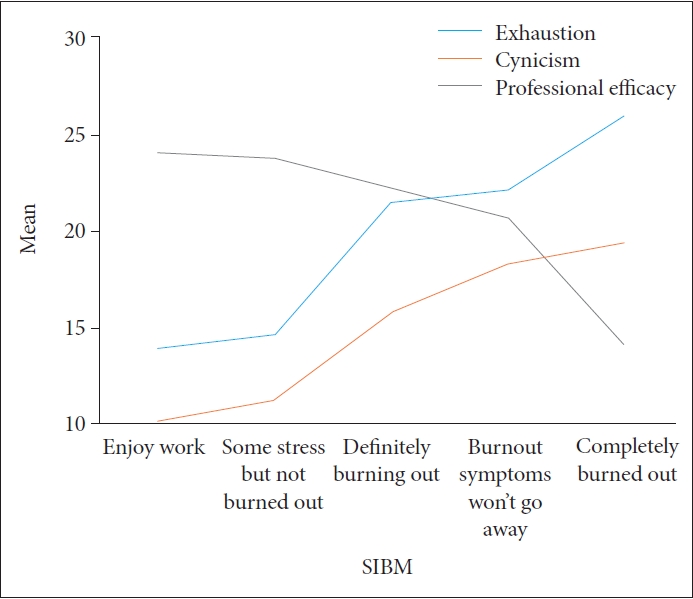5. Southwick FS, Southwick SM. The loss of a sense of control as a major contributor to physician burnout: a neuropsychiatric pathway to prevention and recovery. JAMA Psychiatry 2018;75:665-666.


7. Lemkau JP, Purdy RR, Rafferty JP, Rudisill JR. Correlates of burnout among family practice residents. J Med Educ 1988;63:682-691.


10. Maslach C, Jackson SE, Leiter MP. Maslach burnout inventory manual (3rd ed). Palo Alto, CA: Consulting Psychologists Press; 1996.
11. Maslach C, Jackson SE. The measurement of experienced burnout. J Organ Behav 1981;2:99-113.

12. Maslach C, Jackson SE, Leiter MP. Maslach burnout inventory (3rd ed). In: Zalaquett CP, Wood RJ, editor. Evaluating stress: a book of resources. Lanham, MD: Scarecrow Education, 1997, p. 191-218.
13. Schaufeli WB. The MBI General Survey: MBI-GS. In: Maslach C, Jackson SE, Leiter MP, editors. Maslach burnout inventory manual (4th ed). Menlo Park, CA: Mind Garden, Inc., 1996, p.38-46.
14. Schaufeli WB, Martinez IM, Pinto AM, Salanova M, Bakker AB. Burnout and engagement in university students: a cross-national study. J Cross Cult Psychol 2002;33:464-481.
15. Panagioti M, Panagopoulou E, Bower P, Lewith G, Kontopantelis E, Chew-Graham C, et al. Controlled interventions to reduce burnout in physicians: a systematic review and meta-analysis. JAMA Intern Med 2017;177:195-205.


16. Shanafelt T, Goh J, Sinsky C. The business case for investing in physician well-being. JAMA Intern Med 2017;177:1826-1832.


17. Shanafelt TD, Noseworthy JH. Executive leadership and physician wellbeing: nine organizational strategies to promote engagement and reduce burnout. Mayo Clin Proc 2017;92:129-146.

18. Wright AA, Katz IT. Beyond burnout - redesigning care to restore meaning and sanity for physicians. N Engl J Med 2018;378:309-311.


19. Pomeroy IM, Clark CR, Philp I. The effectiveness of very short scales for depression screening in elderly medical patients. Int J Geriatr Psychiatry 2001;16:321-326.


23. Pick D, Leiter MP. Nurses’ perceptions of burnout: a comparison of selfreports and standardized measures. Can J Nurs Res 1991;23:33-48.

24. Rohland BM, Kruse GR, Rohrer JE. Validation of a single‐item measure of burnout against the Maslach Burnout Inventory among physicians. Stress Health 2004;20:75-79.

25. Schmoldt RA, Freeborn DK, Klevit HD. Physician burnout: recommendations for HMO managers. HMO Pract 1994;8:58-63.

27. Williams ES, Konrad TR, Linzer M, McMurray J, Pathman DE, Gerrity M, et al. Refining the measurement of physician job satisfaction: results from the Physician Worklife Survey. Med Care 1999;37:1140-1154.

29. Shin K. The validity study on Maslach Burnout Inventory-General Survey (MBI-GS). Korean J Ind Organ Psychol 2003;16:1-17.
30. Han C, Jo SA, Kwak JH, Pae CU, Steffens D, Jo I, et al. Validation of the Patient Health Questionnaire-9 Korean version in the elderly population: the Ansan Geriatric study. Compr Psychiatry 2008;49:218-223.


31. Spitzer RL, Kroenke K, Williams JB, the Patient Health Questionnaire Primary Care Study Group. Validation and utility of a self-report version of PRIME-MD: the PHQ primary care study. JAMA 1999;282:1737-1744.


32. An JY, Seo ER, Lim KH, Shin JH, Kim JB. Standardization of the Korean version of screening tool for depression (Patient Health Questionnaire-9, PHQ-9). J Korean Soc Biol Ther Psychiatry 2013;19:47-56.
33. Choi HS, Choi JH, Park KH, Joo KJ, Ga H, Ko HJ, et al. Standardization of the Korean version of Patient Health Questionnaire-9 as a screening instrument for major depressive disorder. J Korean Acad Fam Med 2007;28:114-119.
34. Spitzer RL, Kroenke K, Williams JB, Löwe B. A brief measure for assessing generalized anxiety disorder: the GAD-7. Arch Intern Med 2006;166:1092-1097.


37. Cohen S, Kamarck T, Mermelstein R. A global measure of perceived stress. J Health Soc Behav 1983;24:385-396.


38. Cohen S, Williamson GM. Perceived stress in a probability sample of the United States. In: Spacapan S, Oskamp S, editor. The social psychology of health. Newbury Park, CA: Sage Publications Inc, 1988, p. 31-67.
39. Lee J, Shin C, Ko YH, Lim J, Joe SH, Kim S, et al. The reliability and validity studies of the Korean version of the Perceived Stress Scale. Korean J Psychosom Med 2012;20:127-134.
47. Medak E, Niedzielski A. Effects of COVID-19 on doctors burnout. J Educ Health Sport 2021;11:91-96.













